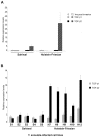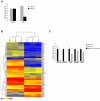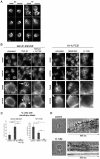TGF-b2 induction regulates invasiveness of Theileria-transformed leukocytes and disease susceptibility
- PMID: 21124992
- PMCID: PMC2987823
- DOI: 10.1371/journal.ppat.1001197
TGF-b2 induction regulates invasiveness of Theileria-transformed leukocytes and disease susceptibility
Abstract
Theileria parasites invade and transform bovine leukocytes causing either East Coast fever (T. parva), or tropical theileriosis (T. annulata). Susceptible animals usually die within weeks of infection, but indigenous infected cattle show markedly reduced pathology, suggesting that host genetic factors may cause disease susceptibility. Attenuated live vaccines are widely used to control tropical theileriosis and attenuation is associated with reduced invasiveness of infected macrophages in vitro. Disease pathogenesis is therefore linked to aggressive invasiveness, rather than uncontrolled proliferation of Theileria-infected leukocytes. We show that the invasive potential of Theileria-transformed leukocytes involves TGF-b signalling. Attenuated live vaccine lines express reduced TGF-b2 and their invasiveness can be rescued with exogenous TGF-b. Importantly, infected macrophages from disease susceptible Holstein-Friesian (HF) cows express more TGF-b2 and traverse Matrigel with great efficiency compared to those from disease-resistant Sahiwal cattle. Thus, TGF-b2 levels correlate with disease susceptibility. Using fluorescence and time-lapse video microscopy we show that Theileria-infected, disease-susceptible HF macrophages exhibit increased actin dynamics in their lamellipodia and podosomal adhesion structures and develop more membrane blebs. TGF-b2-associated invasiveness in HF macrophages has a transcription-independent element that relies on cytoskeleton remodelling via activation of Rho kinase (ROCK). We propose that a TGF-b autocrine loop confers an amoeboid-like motility on Theileria-infected leukocytes, which combines with MMP-dependent motility to drive invasiveness and virulence.
Conflict of interest statement
The authors have declared that no competing interests exist.
Figures





Similar articles
-
Filopodia and membrane blebs drive efficient matrix invasion of macrophages transformed by the intracellular parasite Theileria annulata.PLoS One. 2013 Sep 24;8(9):e75577. doi: 10.1371/journal.pone.0075577. eCollection 2013. PLoS One. 2013. PMID: 24086576 Free PMC article.
-
Interaction between transforming Theileria parasites and their host bovine leukocytes.Mol Microbiol. 2021 May;115(5):860-869. doi: 10.1111/mmi.14642. Epub 2021 Feb 9. Mol Microbiol. 2021. PMID: 33565178 Review.
-
Upregulation of haematopoetic cell kinase (Hck) activity by a secreted parasite effector protein (Ta9) drives proliferation of Theileria annulata-transformed leukocytes.Microb Pathog. 2025 Feb;199:107252. doi: 10.1016/j.micpath.2024.107252. Epub 2024 Dec 25. Microb Pathog. 2025. PMID: 39730099
-
Intracellular Theileria annulata promote invasive cell motility through kinase regulation of the host actin cytoskeleton.PLoS Pathog. 2014 Mar 13;10(3):e1004003. doi: 10.1371/journal.ppat.1004003. eCollection 2014 Mar. PLoS Pathog. 2014. PMID: 24626571 Free PMC article.
-
HIF-1α induction, proliferation and glycolysis of Theileria-infected leukocytes.Cell Microbiol. 2015 Apr;17(4):467-72. doi: 10.1111/cmi.12421. Epub 2015 Feb 26. Cell Microbiol. 2015. PMID: 25620534 Review.
Cited by
-
Trifloxystrobin blocks the growth of Theileria parasites and is a promising drug to treat Buparvaquone resistance.Commun Biol. 2022 Nov 15;5(1):1253. doi: 10.1038/s42003-022-03981-x. Commun Biol. 2022. PMID: 36380082 Free PMC article.
-
Risk Factors for Outbreaks of Lumpy Skin Disease and the Economic Impact in Cattle Farms of Nakuru County, Kenya.Front Vet Sci. 2020 May 29;7:259. doi: 10.3389/fvets.2020.00259. eCollection 2020. Front Vet Sci. 2020. PMID: 32548130 Free PMC article.
-
Filopodia and membrane blebs drive efficient matrix invasion of macrophages transformed by the intracellular parasite Theileria annulata.PLoS One. 2013 Sep 24;8(9):e75577. doi: 10.1371/journal.pone.0075577. eCollection 2013. PLoS One. 2013. PMID: 24086576 Free PMC article.
-
Cell cycle-dependent phosphorylation of Theileria annulata schizont surface proteins.PLoS One. 2014 Jul 31;9(7):e103821. doi: 10.1371/journal.pone.0103821. eCollection 2014. PLoS One. 2014. PMID: 25077614 Free PMC article.
-
Repurposing Auranofin and Evaluation of a New Gold(I) Compound for the Search of Treatment of Human and Cattle Parasitic Diseases: From Protozoa to Helminth Infections.Molecules. 2020 Nov 1;25(21):5075. doi: 10.3390/molecules25215075. Molecules. 2020. PMID: 33139647 Free PMC article.
References
-
- Dobbelaere DA, Rottenberg S. Theileria-induced leukocyte transformation. Curr Opin Microbiol. 2003;6:377–382. - PubMed
-
- Plattner F, Soldati-Favre D. Hijacking of host cellular functions by the Apicomplexa. Annu Rev Microbiol. 2008;62:471–487. - PubMed
-
- Somerville RP, Littlebury P, Pipano E, Brown CG, Shkap V, et al. Phenotypic and genotypic alterations associated with the attenuation of a Theileria annulata vaccine cell line from Turkey. Vaccine. 1998;16:569–575. - PubMed
-
- Adamson R, Logan M, Kinnaird J, Langsley G, Hall R. Loss of matrix metalloproteinase 9 activity in Theileria annulata-attenuated cells is at the transcriptional level and is associated with differentially expressed AP-1 species. Mol Biochem Parasitol. 2000;106:51–61. - PubMed
-
- Lizundia R, Chaussepied M, Huerre M, Werling D, Di Santo JP, et al. c-Jun NH2-terminal kinase/c-Jun signaling promotes survival and metastasis of B lymphocytes transformed by Theileria. Cancer Res. 2006;66:6105–6110. - PubMed
Publication types
MeSH terms
Substances
Grants and funding
LinkOut - more resources
Full Text Sources
Research Materials
Miscellaneous

